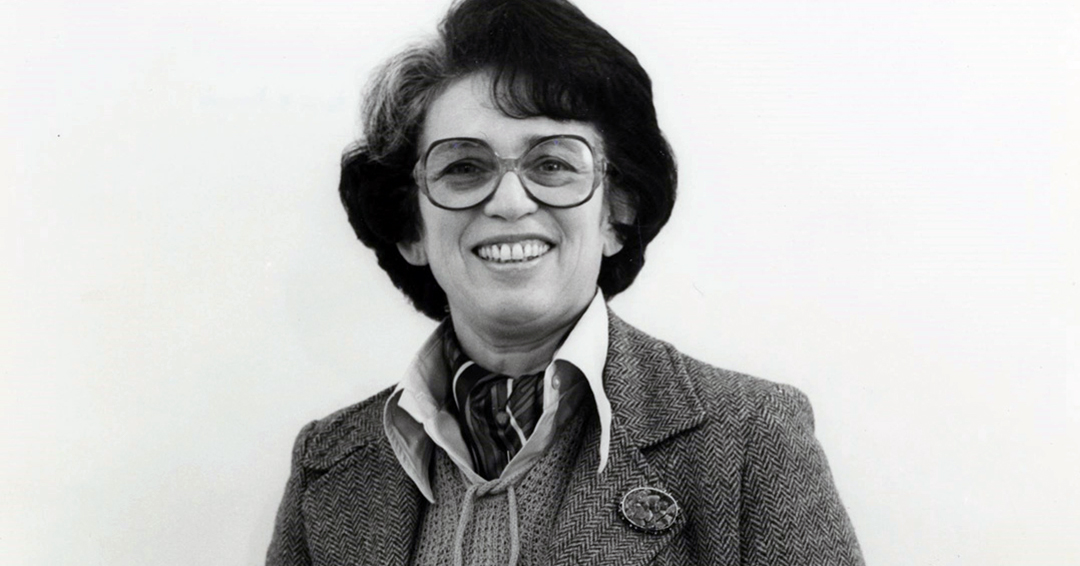
Iconic McGill professor’s groundbreaking discovery impacts therapeutic development to this day
“In science, predicting the significance and outcome of really new work eludes many of us.”
So wrote Rose Johnstone, PhD, in 2003, when she authored a history of the first 60 years of McGill’s Department of Biochemistry. The first (and as yet only) woman to chair that department, Johnstone is known for her discovery of exosomes, a key development that has advanced the field of cell biology.
Little did she know at the time, however, that nearly fifty years later her discovery of exosomes would take on new significance by enabling the development of entirely new kinds of medicines, and with considerable potential to transform the treatment of a wide range of diseases.
Born Rose Mamelak in Poland in 1928, she arrived in Montreal with her family in 1936. Initially speaking no English, she went on to graduate top of her class from Baron Byng High School. Encouraged by her feminist mother, Rose enrolled at McGill, supporting herself with scholarships.
She majored in microbiology but soon switched to the emerging field of biochemistry. As she recalled in her 1984 autobiographical essay (Feeling Outside on the Inside), she had realized, “The study of the chemical elements in living systems filled me with excitement and interest beyond anything I had experienced before.”
A pioneer for women in science
She was awarded her PhD in 1953, the same year she married Douglas Johnstone. They moved to England for two years so she could pursue postdoctoral research. In 1961, she returned to McGill’s Department of Biochemistry as an assistant professor. Promoted to Associate Professor in 1967, she became Full Professor in 1977, and authored 132 peer-reviewed publications.
The first woman to hold the Gilman Cheney Chair in Biochemistry, Johnstone served as Chair of the Department of Biochemistry from 1980 to 1990 — the first woman to lead a basic science department at McGill, and only one of five in North America at that time.
A champion of equal pay for equal work in academia, she served on the Committee on the Status of Women at McGill, helping to challenge gender discrimination. Her son, Michael Johnstone, MDCM, established the Rose Mamelak Johnstone Research Bursary in her memory to encourage women to pursue a scientific career.
Discovery of exosomes
Through her work with red blood cells and iron uptake in the 1970s and 1980s, Johnstone and her research team discovered and named exosomes — vesicles that originate inside our cells to leave and carry proteins and genetic information between cells.
Her research showed that an iron-binding protein was absent from the surface of mature red blood cells. She identified a new vesicle structure that she named the exosome. She discovered that, through the exosome, iron-binding proteins leave reticulocytes (immature red blood cells), enabling the maturation of red blood cells. (Without iron, red blood cells cannot take up or deliver oxygen, and life ceases.)
Johnstone also discovered the unique pathway through which cells secrete exosomes, distinguishing them from other types of vesicles.
Exosomes are now recognized for their role in normal communication among cells in the immune system, the brain and the heart. They are also involved in neurodegenerative disease, liver disease, heart failure and cancer. Scientists had published more than 8,400 papers on exosomes since her discovery, according to the 2019 entry in the Canadian Encyclopedia. Astonishingly today, the number is 31,415 as indicated in the academic depository of peer-reviewed papers, PubMed.
Scientific societies, such as the American Society for Exosomes and Microvesicles and the International Society for Extracellular Vesicles, a journal (Journal of Extracellular Vesicles), databases (ExoCarta, Vesiclepedia) and a research portal (exRNA) are now dedicated to the field that Johnstone’s research helped to establish.
Today, exosomes are emerging as a promising way to deliver precision medicines.. They can be engineered to carry a variety of molecular cargoes, including proteins, lipids, DNA or RNA to recipient cells, making them an ideal vehicle for the delivery of therapeutic agents. This is particularly promising with regards to emerging modalities of RNA therapeutics, for example.
A force of nature
“Rose was a scientist’s scientist. I admired her,” says David Y. Thomas, Canada Research Chair in Molecular Genetics, who chaired the Department of Biochemistry from 2000 to 2013.
Thomas notes that Johnstone’s work provided a foundation for subsequent decades of vital biochemical research. He points to the current work of Janusz Rak, a McGill Professor of Pediatrics and Senior Scientist at the Research Institute of the McGill University Health Centre, whose research includes the study of exosomes and the interruption of intracellular connections in the progression of human cancers.
Another present-day example is the work of McGill alumnus Antonin (Tony) De Fougerolles, PhD, the CEO of Evox Therapeutics, a biotech company focused on “improving the natural delivery capabilities of exosomes and developing an entirely new class of therapeutics,” according to their website.
Notes Thomas Duchaine, PhD, Chair of McGill’s Department of Biochemistry and Director of the McGill Centre for RNA Sciences (MCRS), launched in 2022, “It’s thanks to the foundational work of scientists like Rose Johnstone that the MCRS is harnessing the tremendous potential of RNA functions in biotechnologies and treatments for a broad variety of human diseases.”
The road to curiosity-based science
In 2005, Johnstone authored a paper, “Revisiting the road to the discovery of exosomes.” In it, she describes the long, uncertain process of trial and error, as she and her team discovered, “these small structures, of relatively modest protein content.”
Her closing remarks reflect upon the nature of scientific exploration:
“It may take years for a newly described biological phenomenon to become more than a curiosity and its potential recognized. Once recognized, the growth of interest may be very rapid. Perhaps we are on the doorstep of this latter stage.”
